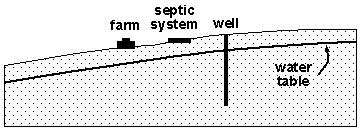ConcepTest: Water Supply Contamination
 This material was originally created for
Starting Point:Introductory Geology
This material was originally created for
Starting Point:Introductory Geology and is replicated here as part of the SERC Pedagogic Service.
Initial Publication Date: May 8, 2006
Question:
A farmer drilled a well into an open aquifer composed of sand and gravel. He installed a septic system downslope from the drinking well (see diagram). A few years later the septic system started to leak. Water tests showed that the well water was clean and uncontaminated by bacteria present in the septic system. Why did the septic system not contaminate the drinking water supply?

a. The bacteria were drowned in the groundwater.
b. The groundwater flow carried water away from the well.
c. Gravel has a low permeability that makes it difficult for bacteria to travel from the septic system to the well.
d. The septic system is not located in the aquifer's recharge zone.

a. The bacteria were drowned in the groundwater.
b. The groundwater flow carried water away from the well.
c. Gravel has a low permeability that makes it difficult for bacteria to travel from the septic system to the well.
d. The septic system is not located in the aquifer's recharge zone.
Student Responses:
No data yet. The correct response is b.
If you would like to help acquire more Before and After statistics for this example, please contact the authors (see link at top of page).
References and Notes:
The use of ConcepTests and Peer Instruction is discussed in detail on the ConcepTest page.
McConnell, D.A., Steer, D.N. and Owens, K.A., 2003, Assessment and Active Learning Strategies for Introductory Geology Courses, Journal of Geoscience Education, 51(2), 205-216.
McConnell, D.A., Steer et al., 2006, Using Conceptests to Assess and Improve Student Conceptual Understanding in Introductory Courses, Journal of Geoscience Education, (54(1), 61-68.
